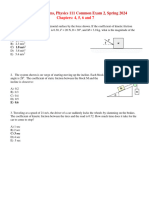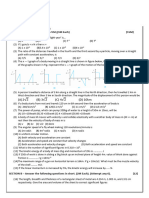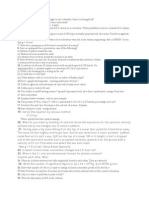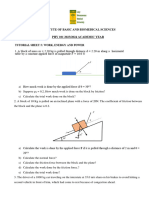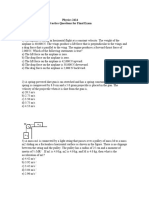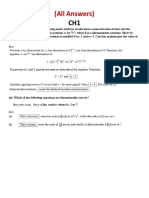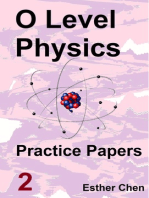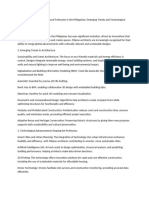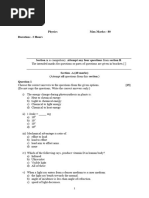Tutorial 2
Uploaded by
Clinton DebrahTutorial 2
Uploaded by
Clinton DebrahDEPARTMENT OF PHYSICS
UNIVERSITY OF CAPE COAST
PHY101: GENERAL PHYSICS 1, GROUPS 17 &18
TUTORIAL SET II
Take g = 10.0 m/s2
1. (a). What do you understand by the term resultant force?
(b). State the Newton’s laws of motion
(c). The only two forces acting on a body have magnitudes of 20 N and 35 N and directions that differ by
80. The resulting acceleration has a magnitude of 20 m/s2. What is the mass of the body?
(d). The horizontal surface on which the block slides is frictionless. If F = 20 N and M = 5.0 kg, what is
the magnitude of the resulting acceleration of the block?
(e). The three forces shown act on a particle.
What is the magnitude and direction of the resultant of these three forces?
2. (a). Define the scalar and vector products of two vectors a and b.
(b). A force F = (6iˆ − 2 ˆj ) N acts on a particle that undergoes a displacement r = (3iˆ + ˆj ) m. Find:
(i). the work done by the force on the particle and (ii). the angle between F and r.
(c). A constant force of 12 N in the positive x direction acts on a 4.0-kg object as it moves from the
origin to the point m. How much work is done by the given force during this displacement?
(d). (i). Given M = 2iˆ − 3 ˆj + kˆ and N = 4iˆ + 5 ˆj − 2kˆ , calculate the vector product M N .
(ii). Two vectors are given by A = iˆ + 2 ˆj and B = −2iˆ + 3 ˆj . Find: (i). A B (ii). the angle between
the two vectors.
3. (a). State the work-energy theorem
(b). A block is pushed across a rough horizontal surface from point A to point B by a force
(magnitude P = 5.4 N) as shown in the figure. The magnitude of the force of friction acting on the
block between A and B is 1.2 N and points A and B are 0.5 m apart. If the kinetic energies of the
block at A and B are 4.0 J and 5.6 J, respectively, how much work is done on the block by the force P
between A and B?
(c). The only force acting on a 2.0-kg body as it moves along the x axis is given by Fx = (12 − 2.0x)
N, where x is in m. The velocity of the body at x = 2.0 m is 5.5 m/s. What is the maximum kinetic
energy attained by the body while moving in the +x direction?
4. (a). State the two (2) properties of conservative forces.
(b). State the relationship between a conservative force (F) and potential energy (U).
(c). A single conservative force Fx = (6.0x − 12) N (x is in m) acts on a particle moving along the x
axis. The potential energy associated with this force is assigned a value of +20 J at x = 0. What is the
potential energy at x = 3.0 m?
(d). A 0.40-kg particle moves under the influence of a single conservative force. At point A where the
particle has a speed of 10 m/s, the potential energy associated with the conservative force is +40 J. As
the particle moves from A to B, the force does +25 J of work on the particle. What is the value of the
potential energy at point B?
5. (a). A certain rain cloud at an altitude of 1.75 km contains 3,20 x 107 kg of water vapour. How long
will it take for a 2.70-kW pump to raise the same amount of water from the Earth’s surface tro the
cloud’s position?
(b). An 82-kg Marine in basic training climbs a 12.0-m vertical rope at a constant speed in 8.00 s.
What is the power output?
(c). A 1.2-kg mass is projected from ground level with a velocity of 30 m/s at some unknown angle
above the horizontal. A short time after being projected, the mass barely clears a 16-m tall fence.
Disregard air resistance and assume the ground is level. What is the kinetic energy of the mass as it
clears the fence?
6. (a). Explain the terms impulse and inertia
(b). Differentiate between elastic and inelastic collisions
(c). A 1 500-kg car traveling east with a speed of 25.0 m/s collides at an intersection with a 2500-kg
truck traveling north at a speed of 20.0 m/s. Find the direction and magnitude of the velocity of the
wreckage after the collision, assuming the vehicles stick together after the collision
(d). An 1800-kg car stopped at a traffic light is struck from the rear by a 900-kg car. The two cars
become entangled, moving along the same path as that of the originally moving car. If the smaller car
was moving at 20.0 m/s before the collision, what is the velocity of the entangled cars after the
collision?
(e). A gun of mass 4.0 kg fires a bullet of mass 10 g at a speed of 60 m/s. What is the initial speed of
recoil of the gun?
(f). A man of mass 80 kg jumps of a trolley of mass 320 kg. If the initial speed of the man is 4 m/s
what is the initial speed of the trolley?
(g). An object has kinetic energy of 275 J and a momentum of magnitude 25.0 kg.m/s. Determine the
speed and mass of the object.
(h). A 10.0-g bullet is fired into a stationary block of wood having mass m= 55.00 kg. The bullet
imbeds into the block. The speed of the bullet-plus-wood combination immediately
after the collision is 0.600 m/s. What was the original speed of the bullet?
7. (a). Define the following terms: angular position, angular displacement, instantaneous angular speed
and instantaneous angular acceleration.
(b). A racing car travels on a circular track of radius 250 m. Assuming the car moves with a constant
speed of 45.0 m/s, find: (i) its angular speed and (ii) the magnitude and direction
of its acceleration.
(c). A highway curve has a radius of 0.14 km and is unbanked. A car weighing 12 kN goes around
the curve at a speed of 24 m/s without slipping. What is the magnitude of the horizontal force of the
road on the car?
(d). Determine the centripetal force acting upon a 40-kg child who makes 10 revolutions around the
Cliffhanger in 29.3 seconds. The radius of the barrel is 2.90 meters.
8. (a). Define the following terms: stress, strain, Young’s modulus, shear modulus and bulk modulus
(b). A rod, 120 cm long and of diameter 3.0 cm is subjected to an axial pull of 18 kN. Calculate the
stress in N/m2.
(c) Find the minimum diameter of a steel wire 18 m long that will stretch no more than 9 mm when a
load of 380 kg is hung on the lower end. (Ysteel = 2.0 1011 N/m2).
(d) A 20-m long steel wire (cross-section 1.0 cm2, Young's modulus 2.0 1011 N/m2), is subjected to
a load of 25 000 N. How much will the wire stretch under the load?
(e) How large a force is necessary to stretch a 2.0-mm diameter copper wire (Y = 11 1010 N/m2) by
1.0%?
You might also like
- Harry B. Joseph - Book of Wisdom. 1-Revival of Wisdom91% (67)Harry B. Joseph - Book of Wisdom. 1-Revival of Wisdom123 pages
- COSMIC CONSCIOUSNESS OF HUMANITY - PROBLEMS OF NEW COSMOGONY (V.P.Kaznacheev,. Л. V. Trofimov.)94% (212)COSMIC CONSCIOUSNESS OF HUMANITY - PROBLEMS OF NEW COSMOGONY (V.P.Kaznacheev,. Л. V. Trofimov.)212 pages
- Quantum Magick Reconfiguring The Field, A Powerful Companion To Mind Magic Methods (The Mind Magic System Book 2) (Merlin Starlight) (Z-Library)92% (12)Quantum Magick Reconfiguring The Field, A Powerful Companion To Mind Magic Methods (The Mind Magic System Book 2) (Merlin Starlight) (Z-Library)225 pages
- Student Exploration: Fan Cart Physics (Answer Key)46% (24)Student Exploration: Fan Cart Physics (Answer Key)4 pages
- The Road From Orion (The Isis Thesis Book 1)100% (19)The Road From Orion (The Isis Thesis Book 1)178 pages
- Astrological Transits - The Beginner's Guide To Using Planetary Cycles To Plan and Predict Your Day, Week, Year (Or Destiny)90% (31)Astrological Transits - The Beginner's Guide To Using Planetary Cycles To Plan and Predict Your Day, Week, Year (Or Destiny)317 pages
- Journey To The Year 3000 - Choose Your Own Super Adventure100% (2)Journey To The Year 3000 - Choose Your Own Super Adventure90 pages
- Practice Problems, Physics 111, Common Exam 2, Spring 2024No ratings yetPractice Problems, Physics 111, Common Exam 2, Spring 20247 pages
- General Physics Worksheet For Freshman Unity100% (1)General Physics Worksheet For Freshman Unity3 pages
- MULTIPLE CHOICE. Choose The One Alternative That Best Completes The Statement or Answers TheNo ratings yetMULTIPLE CHOICE. Choose The One Alternative That Best Completes The Statement or Answers The7 pages
- Work Energy Power and Efficiency IB Worksheet100% (2)Work Energy Power and Efficiency IB Worksheet12 pages
- Screenshot 2024-01-26 at 1.11.22 at NightNo ratings yetScreenshot 2024-01-26 at 1.11.22 at Night2 pages
- X Write The Answer of The Following Questions. (Each Carries 3 Marks)No ratings yetX Write The Answer of The Following Questions. (Each Carries 3 Marks)32 pages
- Book of Wisdom Part 1 Revival of Wisdom (22 28)100% (10)Book of Wisdom Part 1 Revival of Wisdom (22 28)7 pages
- A Short History of Nearly Everything - SuperSummary Study Guide100% (1)A Short History of Nearly Everything - SuperSummary Study Guide57 pages
- Andromeda: The Chained Woman: Joshua Wihongi Physics 1040 Sp17 Constellation PaperNo ratings yetAndromeda: The Chained Woman: Joshua Wihongi Physics 1040 Sp17 Constellation Paper11 pages
- Water Security - Assignment Q. No. 4 & 5 (Sunil & Linette)No ratings yetWater Security - Assignment Q. No. 4 & 5 (Sunil & Linette)8 pages
- 1. Liam_F1_vs_Conventional_Wind_TurbinesNo ratings yet1. Liam_F1_vs_Conventional_Wind_Turbines10 pages
- Artificial Lighting System & Daylight Control: Residential: Interior Design Assignment III100% (9)Artificial Lighting System & Daylight Control: Residential: Interior Design Assignment III14 pages
- 23 Automatic Battery Chargers 23 January 2018 - ENNo ratings yet23 Automatic Battery Chargers 23 January 2018 - EN8 pages
- ADNOC Distribution Employment Application FormsNo ratings yetADNOC Distribution Employment Application Forms2 pages
- Ongoing Projects at Global Vipassana Pagoda 2024 - 240413 - 140744No ratings yetOngoing Projects at Global Vipassana Pagoda 2024 - 240413 - 1407441 page
- FEDR15180 - Discharge Nozzle 180º FEDRxx180 - Rv04No ratings yetFEDR15180 - Discharge Nozzle 180º FEDRxx180 - Rv043 pages
- How to prevent machine malfunctions and electronic damageNo ratings yetHow to prevent machine malfunctions and electronic damage16 pages
- Total 7 Bearings:-2 at Fdgs (1 & 1.5), 1 LP Front 2 LP Aft, 1 HP Front 1 HP Rear. But WillNo ratings yetTotal 7 Bearings:-2 at Fdgs (1 & 1.5), 1 LP Front 2 LP Aft, 1 HP Front 1 HP Rear. But Will15 pages
- MPPWD SOR Electrical) Electrical 01-12-2020No ratings yetMPPWD SOR Electrical) Electrical 01-12-2020304 pages






















